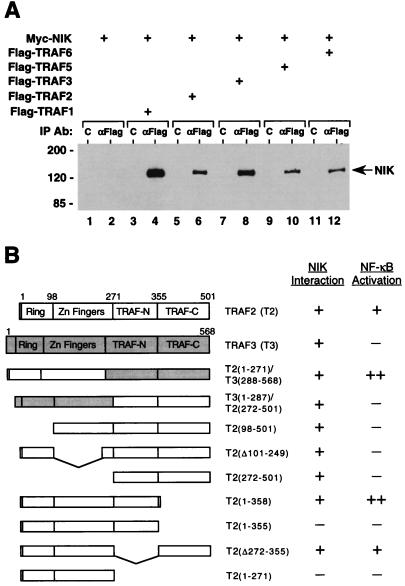Figure 2.
Interaction of NIK with TRAF proteins. (A) Association of NIK with members of the TRAF family. 293 cells were transiently cotransfected with epitope-tagged NIK (lanes 1–12) and TRAF expression vectors (3 μg; lanes 3–12) as indicated. After 24 h, cell lysates were prepared and Flag epitope-tagged TRAF proteins were immunoprecipitated with anti-Flag epitope mAb (lanes 2, 4, 6, 8, 10, and 12) or control mAb (lanes 1, 3, 5, 7, 9, and 11). Coprecipitating Myc epitope-tagged NIK was detected by immunoblot analysis using anti-Myc epitope polyclonal antibodies. The position of molecular mass markers (in kilodaltons) is shown on the left. (B) Interaction of NIK with TRAF mutants; 293 cells were transiently cotransfected with expression vectors for Myc epitope-tagged NIK and the indicated HA epitope-tagged wild-type and mutant TRAF proteins. After 24 h, aliquots of cell lysates were immunoprecipitated with anti-HA epitope mAb or control mAb. Coprecipitating NIK was detected by immunoblot analysis with anti-Myc epitope polyclonal antibodies. +, binding of NIK to the respective TRAF proteins; −, lack of such an interaction in this assay. Also listed is the ability of the indicated TRAF proteins to activate an NF-κB-dependent reporter gene in transient transfection assays (33).

